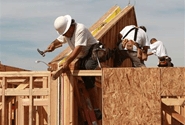Steel Markets

AGC Reports Sharp Jump in Canceled Construction Projects
Written by Tim Triplett
March 28, 2020
Thirty-nine percent of contractors report that project owners have halted or canceled current construction projects amid deteriorating economic conditions, according to a survey by the Associated General Contractors of America. The project cancellations are particularly severe in light of new data showing that 42 states added construction jobs through February.
“The abrupt plunge in economic activity is taking a swift and severe toll on construction,” said Ken Simonson, the association’s chief economist, noting that only 18 percent of respondents have been ordered to halt work by elected officials. “The sudden drop in demand stands in sharp contrast to the strong employment levels this industry was experiencing just a few weeks ago.”
In the association’s latest online survey, conducted March 23-26, 45 percent of the 1,640 respondents reported experiencing project delays or disruptions. Shortages of material, parts and equipment, including vital personal protective equipment for workers such as respirators, were reported by 23 percent of respondents. Eighteen percent reported shortages of craftworkers, while 16 percent said projects were delayed by shortages of government workers needed for inspections, permits and other actions. Thirteen percent said delay or disruption had occurred because a potentially infected person had visited a jobsite.
The survey also found that 35 percent of firms said suppliers had notified them or their subcontractors that some deliveries would be delayed or canceled. Only 22 percent reported similar supply chain challenges last week. That survey was conducted March 17-19. However, 8 percent of firms did report they have added new work expanding health care and other facilities needed to respond to the growing health crisis.
In contrast to the rapidly deteriorating current market conditions, the association also released new construction employment data showing that most states – 42 – added construction jobs between February 2019 and February 2020. Industry employment declined over the year in eight states and the District of Columbia. From January to February, 37 states and D.C. added construction jobs, while 11 states shed jobs and two states had no change.
Association officials warned that while the coronavirus relief measure…will provide some immediate help for construction workers and their employers, Congress must do more to protect high-paying construction jobs. They said new investments in infrastructure, relief from losses incurred on delayed or canceled federally funded projects and protections for multi-employer pensions will help the industry recover from the economic impacts of the pandemic.
“The steps firms are taking to protect workers from the coronavirus unfortunately won’t be enough to save many of them from the economic damage the pandemic is creating,” said Stephen E. Sandherr, the association’s chief executive officer. “Construction workers and employers need more than a lifeline, they need a recovery plan.”

Tim Triplett
Read more from Tim TriplettLatest in Steel Markets

CMC looks beyond Arizona micro-mill woes to long-term viability of construction mart
Despite the economic and geopolitical upheaval of the last five years, CMC President and CEO Peter Matt points out that the construction market has been an essential element of the way forward.

US importers face stricter rules under revamped S232 tariffs
“CBP expects full compliance from the trade community for accurate reporting and payment of the additional duties. CBP will take enforcement action on non-compliance," the agency said in a March 7 bulletin.

Steel exports rebound in January
US steel exports recovered to a five-month high in January after having fallen to a two-year low in December. This growth follows four consecutive months of declining exports.

Construction spending drops marginally in January
Construction spending edged down slightly in January, slipping for the first time in four months. The US Census Bureau estimated spending at a seasonally adjusted annual rate of $2,196 billion in January, down 0.2% from December’s downward revised rate. The January figure is 3.3% higher than a year ago. January’s result, despite the slight erosion, […]

HVAC equipment shipments slow in December but strong annually
Shipments of heating and cooling equipment in the US fell to an 11-month low in December, according to the latest data released by the Air-Conditioning, Heating, and Refrigeration Institute (AHRI).
